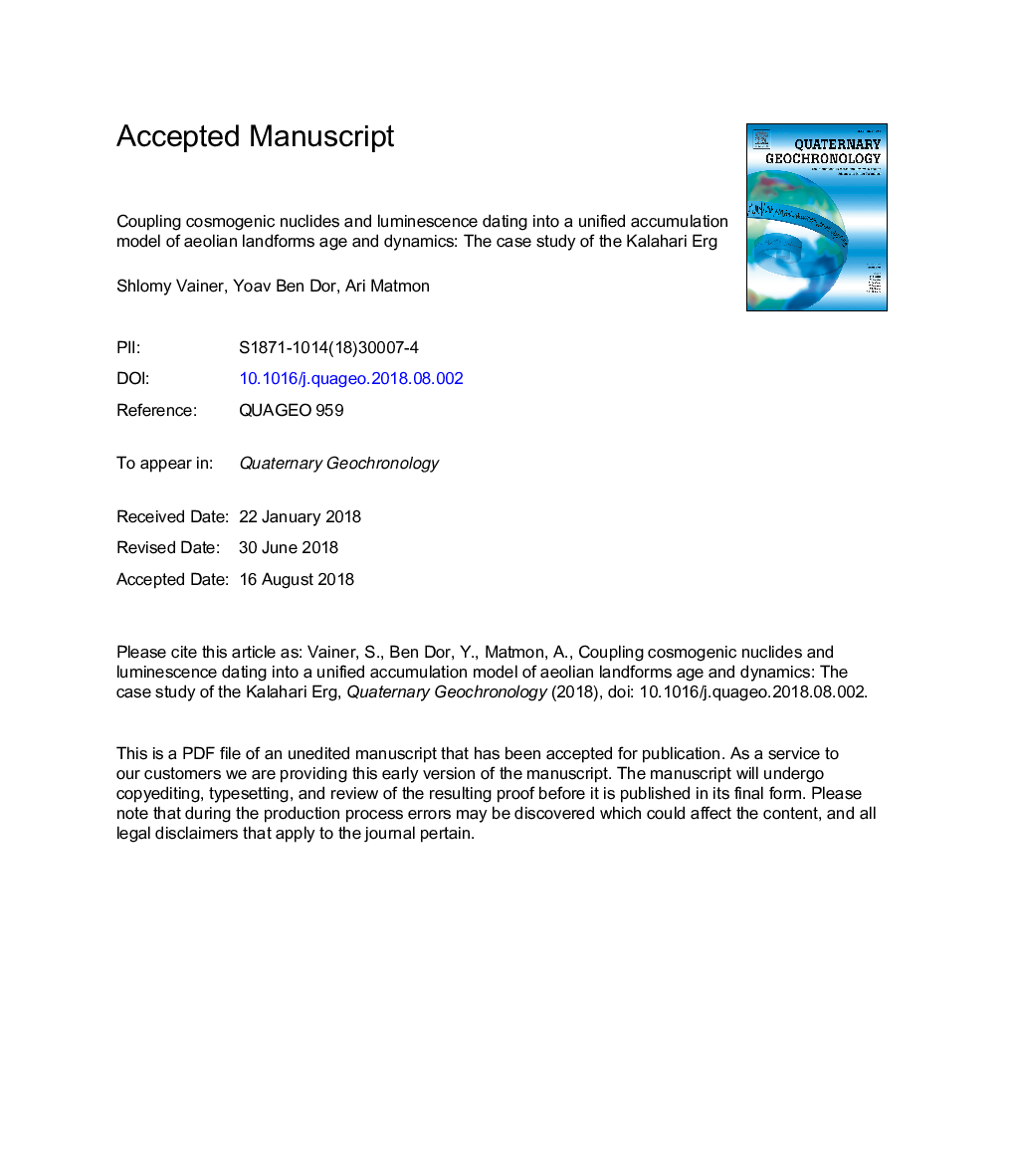| کد مقاله | کد نشریه | سال انتشار | مقاله انگلیسی | نسخه تمام متن |
|---|---|---|---|---|
| 11033072 | 1639828 | 2018 | 34 صفحه PDF | دانلود رایگان |
عنوان انگلیسی مقاله ISI
Coupling cosmogenic nuclides and luminescence dating into a unified accumulation model of aeolian landforms age and dynamics: The case study of the Kalahari Erg
ترجمه فارسی عنوان
نوکلئوتید های همجنس گرایی و لومینسانس به یک مدل انباشته متحرک از سن و دینامیک زمین شناسی ائولین می پردازند: مطالعه موردی ارگ کلهاری
دانلود مقاله + سفارش ترجمه
دانلود مقاله ISI انگلیسی
رایگان برای ایرانیان
موضوعات مرتبط
مهندسی و علوم پایه
علوم زمین و سیارات
ژئوشیمی و پترولوژی
چکیده انگلیسی
Sand deposits cover extensive areas both in the northern and southern hemispheres and the timing and chronology and processes that govern their dynamics are of major interest. Luminescence-based dating methods, are used to date episodic aeolian events but are restricted to late Quaternary deposits, and only reveal the last cycle of sediment burial and not the time of sand existence in the landscape. Burial ages modelled from cosmogenic nuclides reach further back in time, but are usually inferred as minimal deposition ages. It is apparent that standard dating methods, when applied individually, have limited applicability for determining both the age and the processes that form aeolian deposits. This study presents an approach that integrates luminescence dating and cosmogenic burial dating into a stochastic model developed to reproduce sand formation and migration. The model is based on a process in which quartz grains are vertically displaced through a sand column simulating dune migration across the landscape. A range of vertical displacement rates is compiled from published luminescence ages of dated dune fields of varied settings throughout the world. Using these vertical movement rates, sand is recycled up and down a depth profile coupled with a step-wise calculations of cosmogenic nuclides accumulation and decay, alongside OSL signal accumulation. When the modelled sand grains are buried, their luminescence signal grows while 26Al and 10Be decay or accumulate as a function of their respective radioactive decay and production rate, which is governed by cosmic rays attenuation. When sand is exposed at the surface, the luminescence signal is reset and cosmogenic nuclide production is maximized. Each simulation is terminated when the modelled concentrations of 26Al and 10Be reach measured concentrations in actual sand samples. Luminescence data therefore provide the time since last exposure at the surface (i.e. the last depositional cycle), whereas the cosmogenic nuclides provide a long-term estimate of sand residence in the landscape reflecting also weathering and erosion of the source bedrock. The southern Kalahari dune field at Mamatwan, South Africa, is used as a case study to test the presented approach. Model results show that optically stimulated luminescence ages which range between 1 and 10â¯Ka, only reflect the last cycle of sand migration, while cosmogenic nuclides minimal burial ages are greater than 1â¯Ma. Furthermore, the simulation results indicate two peaks at 1.5-2.2â¯Ma and at 4.2-5.2â¯Ma, suggesting two main phases of sand introduction to the Kalahari during the Pliocene and Pleistocene. Finally, the modelled ages are concurrent with regional environmental and climatic events. The model presented in this study provides a powerful tool for estimating the emergence of sand in a given landscape, and also for understanding the dynamic evolution of any dune field and the mechanisms behind dune migration.
ناشر
Database: Elsevier - ScienceDirect (ساینس دایرکت)
Journal: Quaternary Geochronology - Volume 48, October 2018, Pages 133-144
Journal: Quaternary Geochronology - Volume 48, October 2018, Pages 133-144
نویسندگان
Shlomy Vainer, Yoav Ben Dor, Ari Matmon,
